San Antonio, Texas, Hgh State Clinic, Hgh Injections, Hrt Doctors
San Antonio, Texas Blood Testing Facilities
 Represents a LabCorp blood testing facility
Represents a LabCorp blood testing facility Represents a Quest Diagnostics blood testing facility
Represents a Quest Diagnostics blood testing facility
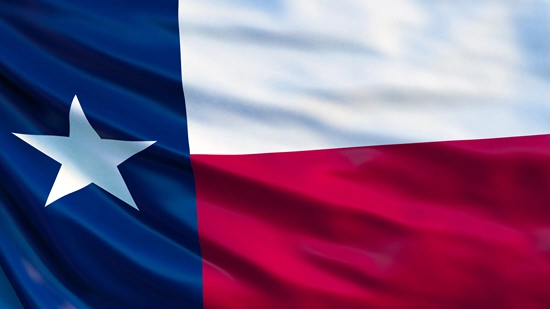
Nearby Labcorp Blood Testing facilities:
- Labcorp Center Distance: 0 m, 1200 Brooklyn Ave Ste 165, San Antonio, Bexar County, TX, 78212
- Labcorp Center Distance: 1 m, 1303 Mccullough Ave Ste 429, San Antonio, Bexar County, TX, 78212
- Labcorp Center Distance: 5 m, 3103 S.E. Military Dr Ste 104, San Antonio, Bexar County, TX, 78223
- Labcorp Center Distance: 6 m, 7390 Barlite Blvd Ste 135, San Antonio, Bexar County, TX, 78224
- Labcorp Center Distance: 7 m, 8601 Village Dr Ste 202, San Antonio, Bexar County, TX, 78217
- Labcorp Center Distance: 8 m, 5282 Medical Dr Ste 190, San Antonio, Bexar County, TX, 78229
- Labcorp Center Distance: 12 m, 12602 Toepperwein Rd Ste 220, Live Oak, Bexar County, TX, 78233
- Labcorp Center Distance: 13 m, 3903 Wiseman Blvd Suite 219, San Antonio, Bexar County, TX, 78251
- Labcorp Center Distance: 28 m, 124 E Bandera Rd Ste 303, Boerne, Kendall County, TX, 78006
- Labcorp Center Distance: 30 m, 1528 Common St Ste 6, New Braunfels, Comal County, TX, 78130
- Labcorp Center Distance: 31 m, 2115 Stephen's Place 1200, New Braunfels, Comal County, TX, 78130
- Labcorp Center Distance: 69 m, 4207 James Casey St Ste 101, Austin, Travis County, TX, 78745
- Labcorp Center Distance: 75 m, 711 W 38Th St Suite B-2, Austin, Travis County, TX, 78705
- Labcorp Center Distance: 77 m, 3040 East Main Suite Z, Uvalde, Uvalde County, TX, 78801
- Labcorp Center Distance: 88 m, 16030 Park Valley Suite 200, Round Rock, Williamson County, TX, 78681
Nearby Quest Blood Testing facilities:
- Quest Center Distance: 1 m, 1303 Mccullough Ave, San Antonio, Bexar County, TX, 78212-5628
- Quest Center Distance: 8 m, 6100 Bandera Road, San Antonio, Bexar County, TX, 78238-1666
- Quest Center Distance: 13 m, 18707 Hardy Oak Blvd, San Antonio, Bexar County, TX, 78258-4891
- Quest Center Distance: 26 m, 305 Singing Oaks, Spring Branch, Comal County, TX, 78070-6505
- Quest Center Distance: 33 m, 2151 W Oaklawn Rd, Pleasanton, Atascosa County, TX, 78064-4604
- Quest Center Distance: 70 m, 2301 Ranch Rd 620 South, Lakeway, Travis County, TX, 78734-6240
- Quest Center Distance: 75 m, 3708 Jefferson Street, Austin, Travis County, TX, 78731-6206
- Quest Center Distance: 83 m, 1652 E Houston Street, Beeville, Bee County, TX, 78102-5313
- Quest Center Distance: 88 m, 651 N. Us Hwy 183, Leander, Williamson County, TX, 78641-7001
San Antonio Hormone Replacement Therapy Services
Are you a resident of San Antonio or the surrounding area, and over the age of thirty? Do you feel that Hormone Imbalance may be having a negative impact on your health and wellness? If so, the Conscious Evolution Institute is here to help. We are a licensed and board-certified medical clinic that specializes in Hormone Restoration and Optimization Services for men and women all across Texas and the United States.
We have medical affiliates all throughout Bexar County that can help us perform all the necessary testing needed to establish your Hormone Health and your need for treatment. We offer HGH, Testosterone, Sermorelin, and a variety of other treatments designed to improve your hormone health and get you feeling and looking better than you have in years.
We only offer the best Hormone Therapy Treatments available in America today, and we are a trusted provider of Legal Hormone Prescriptions for patients in need. If you feel that you may be suffering from Hormone Deficiency, or if you are just growing older and are looking for a way to get the weight off your shoulders, we may be able to help you! Just give us a call or contact us by filling out the form to your left to get started!
San Antonio Low-T Therapy Solutions
Testosterone Replacement is one of the great services we provide at the Conscious Evolution Institute. Low-T is a serious and significant medical condition that too often gets overlooked. Many men recognize the changes in their sexual health, but don't realize the other major effects that Testosterone Deficiency and Andropause can have.
Testosterone is a potent anabolic hormone which supports masculinity and traits associated with it. Testosterone Deficiency makes it harder to gain muscle and leads to weight gain. It leads to feelings of anxiety and depression and leads to a lack of confidence. Testosterone Deficiency has also been shown in the research to be bad for cardiovascular and cognitive health.
With our help, we can find out if you are suffering from Testosterone Deficiency, or otherwise help uncover the root cause of your health changes. If you qualify for Testosterone Treatment, we offer a variety of highly effective Low-T Treatments including Testosterone Gels, Testosterone Injections, and Testosterone Patches.
San Antonio Human Growth Hormone Therapy
HGH Deficiency is a potentially serious medical condition that can afflict both men and women as they grow older. The purpose of Human Growth Hormone in adult patients is to sustain and support physiological function throughout the body by improving cellular metabolism and activity. As HGH Levels start to drop, it can lead to a variety of symptoms that have a negative effect upon health and wellness.
As metabolism drops, body fat starts to increase, and muscle mass starts to drop. HGH has also been strongly associated with cognitive health, and patients with inhibited HGH Levels are more likely to experience conditions such as Alzheimer's and Dementia. Human Growth Hormone is also incredibly important for maintaining the healthy function of the Immune System, and it helps patients recover from injuries and damage more quickly, including skin damage from the sun and other sources. HGH Injection Therapy can help restore HGH Levels to those associated with early adulthood, and, when combined with a healthy nutrition and exercise regimen, it can lead to immense benefits.
San Antonio Sermorelin Acetate
Of course, HGH Injections are not the only option available to patients that are diagnosed with HGH Deficiency. Sermorelin Acetate is also an option on the table, an option many people think is actually superior to Human Growth Hormone. Sermorelin is an analogue of a hormone made by the Hypothalamus known as GH-RH. This hormone actually has the ability to stimulate the production of Human Growth Hormone.
Using Sermorelin Acetate, it is easier to replicate the natural rhythm of Hormone Release in the brain, increasing the effectiveness and reducing the risk of side-effects associated with the treatment. Also, Sermorelin is cheaper than HGH and can be prescribed off label, which also draws many patients and their doctors to the treatment.
San Antonio HCG Diet Therapy
The Conscious Evolution Institute also offers Clinical Hormone Treatments designed to help you improve your figure and lose weight, such as the HCG Diet. HCG is a Bio-Identical Hormone Therapy, that has the ability to help patients lose as much as thirty pounds per month. These daily injections, when combined with a caloric-restrictive diet, improve the body's metabolism and encourage the body to burn fat before muscle. Also, HCG helps suppress the feelings of hunger and fatigue that can sometimes be associated with such diets!
Information about San Antonio, Texas
San Antonio is the 2nd most populated city in Texas, behind only Houston. San Antonio means Saint Anthony in English, a 13th century Italian saint, who is recognized as the patron saint of the American Indians. San Antonio goes by a number of nicknames, including Countdown City, Military City USA, and San Antone.
As you might guess from its nickname, San Antonio has a huge military presence, and is the home of Fort Sam Houston, METC, and Lackland Air Force Base. Many people know about San Antonio primarily because it is the home of the Alamo, which has been famously represented in media over the last century. San Antonio is also home to one major professional sports team—the San Antonio Spurs. The largest college in San Antonio is the University of Texas-San Antonio, whose mascot is the road runner.
San Antonio has a large economy which is involved in a wide variety of fields, most notably military and health. There are a number of defense contractors operating in the city, and the city is also a major oil producing center. The two largest companies operating out of San Antonio are Tesoro Corporation and Valero Energy Corporation, which both deal heavily in national and international fossil fuels. The city is also a major tourist attraction, owing largely to the Alamo, but also to beautiful sights such as the Riverwalk and wonderful museums such as the San Antonio Museum of Art and the McNay Art Museum.
All About San Antonio, Texas Geographic Area
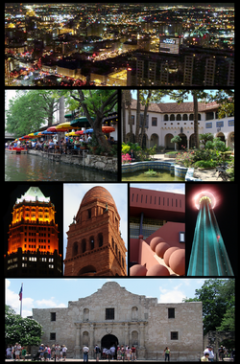
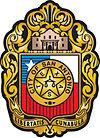
San Antonio ( /ËusR¦nR¦nËntoÊoni.oÊo/) (Spanish for "Saint Anthony") is the seventh most populous city in the United States of America and the second most populous city in the state of Texas, with a population of 1.3 million. It was the fastest growing of the top 10 largest cities in the United States from 2000-2010, and the second from 1990-2000. The city is located in the American Southwest, the south aecentral part of Texas, and the southwestern corner of an urban region known as the Texas Triangle.
/ËusR¦nR¦nËntoÊoni.oÊo/) (Spanish for "Saint Anthony") is the seventh most populous city in the United States of America and the second most populous city in the state of Texas, with a population of 1.3 million. It was the fastest growing of the top 10 largest cities in the United States from 2000-2010, and the second from 1990-2000. The city is located in the American Southwest, the south aecentral part of Texas, and the southwestern corner of an urban region known as the Texas Triangle.
San Antonio serves as the seat of Bexar County. The city has characteristics of other western urban centers in which there are sparsely populated areas and a low density rate outside of the city limits. The city is the anchor municipality of the San Antonio-New Braunfels metropolitan area; the other principal city is its largest suburb, New Braunfels. Commonly referred to as Greater San Antonio, the metropolitan area has a population of just under 2.2 million based on the 2011 U.S. Census estimate, making it the 24th-largest metropolitan area in the United States and third-largest in the state of Texas.
San Antonio was named for Saint Anthony of Padua, whose feast day is on June 13, when a Spanish expedition stopped in the area in 1691. Famous for Spanish missions, the Alamo, the River Walk, the Tower of the Americas, the Alamo Bowl, Marriage Island and host to SeaWorld and Six Flags Fiesta Texas theme parks, the city is visited by approximately 26 million tourists per year according to the San Antonio Convention and Visitors Bureau. The city is home to the four-time NBA champion San Antonio Spurs and the annual San Antonio Stock Show & Rodeo, one of the largest in the country.
San Antonio has a strong military presence aeit is home to Fort Sam Houston, Lackland Air Force Base, Randolph Air Force Base, and Brooks City-Base, with Camp Bullis and Camp Stanley outside the city. Kelly Air Force Base operated out of San Antonio until 2001, when the airfield was transferred over to Lackland AFB and the remaining portions of the base became Port San Antonio, an industrial/business park. San Antonio is home to five Fortune 500 companies and the South Texas Medical Center, the only medical research and care provider in the South Texas region.
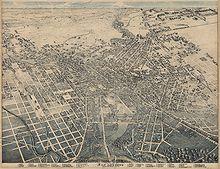
Payaya Indians originally lived near the San Antonio River Valley, in the San Pedro Springs area, calling the vicinity Yanaguana, meaning "refreshing waters". In 1691, a group of Spanish explorers and missionaries came upon the river and Native American settlement on June 13, the feast day of St. Anthony of Padua, and named the place and river "San Antonio" in his honor.
Early Spanish settlement of San Antonio began with the Martin de Alarcon expedition and the establishment of the San Antonio de Valero Mission (now the Alamo) as a means to reassert Spanish dominance over Texas from the nearby French in Louisiana. The viceroy, at the instigation of Father Antonio de San Buenaventura y Olivares, made the suppression of illicit trade from Louisiana a primary objective. He also pledged support for the Franciscan missions in Texas.
Father Olivares had earlier made a visit to a site on the San Antonio River in 1709, and from that time forward he was determined to found a mission and civilian settlement there. The viceroy gave formal approval for a halfway mission and presidio in late 1716, and assigned responsibility for their establishment to Martin de AlarcR³n, the governor of Coahuila and Texas. A series of delays, however, occasioned in part by differences between AlarcR³n and Olivares, postponed definitive action until 1718.
The families clustered around the presidio and mission formed the beginnings of Villa de Bejar, destined to become the most important town in Spanish Texas. On May 1, on the San Antonio River, the governor founded Mission San Antonio de Valero (later famous as the Alamo), and on May 5, 1718 established the Presidio San Antonio de Bexar ("Bejar" in modern Spanish orthography) on the west side of the San Antonio River one-fourth league from the San Antonio de Valero Mission.
On February 14, 1719, the Marquis of San Miguel de Aguayo made a report to the king of Spain proposing that 400 families be transported from the Canary Islands, Galicia, or Havana to populate the province of Texas. His plan was approved, and notice was given the Canary Islanders (isleR±os) to furnish 200 families; the Council of the Indies suggested that 400 families should be sent from the Canaries to Texas by way of Havana and Veracruz. By June 1730, 25 families had reached Cuba and 10 families had been sent on to Veracruz before orders from Spain to stop the movement arrived.
Under the leadership of Juan Leal Goraz, the group marched overland to the Presidio San Antonio de Bexar, where they arrived on March 9, 1731. The party had increased by marriages on the way to 15 families, a total of 56 persons. They joined a military community that had been in existence since 1718. The immigrants formed the nucleus of the villa of San Fernando de Bexar, the first regularly organized civil government in Texas. Several of the old families of San Antonio trace their descent from the Canary Island colonists. MarRa Rosa PadrR³n was the first baby born of Canary Islander descent in San Antonio.
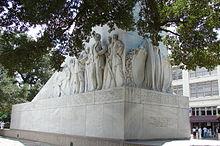
San Antonio grew to become the largest Spanish settlement in Texas, and for most of its history, the capital of the Spanish, later Mexican, province of Tejas. From San Antonio, the Camino Real, today Nacogdoches Road in San Antonio, ran to the American border at the small frontier town of Nacogdoches. When Antonio LR³pez de Santa Anna unilaterally abolished the Mexican Constitution of 1824, violence ensued in many states of Mexico.
In a series of battles, the Texian Army succeeded in forcing Mexican soldiers out of the settlement areas east of San Antonio. Under the leadership of Ben Milam, in the Battle of Bexar, December, 1835, Texian forces captured San Antonio from forces commanded by General Martin Perfecto de Cos, Santa Anna's brother-in-law. In the spring of 1836, Santa Anna marched on San Antonio. A volunteer force under the command of James C. Neill occupied and fortified the deserted mission.
Upon his departure, the joint command of William Barrett Travis and James Bowie were left in charge of defending the old mission. The Battle of the Alamo took place from February 23 to March 6, 1836. The outnumbered Texian force was ultimately defeated, with all of the Alamo defenders killed. These men were seen as "martyrs" for the cause of Texas freedom and "Remember the Alamo" became a rallying cry in the Texian Army's eventual success at defeating Santa Anna's army.
Juan SeguRn, who organized the company of Tejano patriots, who fought and died for Texas independence at the Battle of the Alamo, fought at the Battle of Concepcion, Siege of Bexar, and the Battle of San Jacinto, and served as mayor of San Antonio. He was forced out of that office, due to threats on his life, by sectarian newcomers and political opponents in 1842, becoming the last Tejano mayor for nearly 150 years.
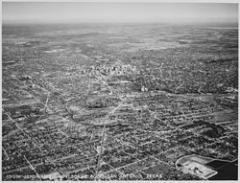
In 1845, the United States finally decided to annex Texas and include it as a state in the Union. This led to the Mexican-American War. Though the U.S. ultimately won, the war was devastating to San Antonio, and, at its end, the population of the city had been reduced by almost two-thirds, to only 800 inhabitants. By 1860, at the start of the Civil War, San Antonio had grown to a city of 15,000 people.
Following the Civil War, San Antonio prospered as a center of the cattle industry. During this period, it remained a frontier city, but its mixture of cultures also gave it a reputation as being beautiful and exotic. Frederick Law Olmstead, the architect who designed Central Park in New York City, once described San Antonio as having a "jumble of races, costumes, languages, and buildings," which gave it a quality which only New Orleans could rival in, "odd and antiquated foreignness."
In 1877, the first railroad reached San Antonio and the city was no longer on the frontier, but began to enter the mainstream of American society. At the beginning of the 20th century, the streets of Downtown were widened to accommodate street cars and modern traffic, destroying many historic buildings in the process.
Like many municipalities in the American Southwest, San Antonio experiences steady population growth. The city's population has nearly doubled in 35 years, from just over 650,000 in the 1970 census to an estimated 1.2 million in 2005 through both steady population growth and land annexation (considerably enlarging the physical area of the city). In 1990, the Census Bureau reported San Antonio's population as 55.6% Hispanic, 7% black, and 36.2% non-Hispanic white.
San Antonio is located near 29.5 °N 98.5 °W. It is about 75 miles to the southwest of its neighboring city, Austin, the state capitol. The city is also about 190 miles west of Houston and about 250 miles south of the Dallas/Fort Worth area. According to the United States Census Bureau, in 2000 the city had a total area of 412.07 square miles (1,067.3 km2) ae407.56 square miles (1,055.6 km2) (98.9%) of land and 4.51 square miles (11.7 km2) (1.1%) of water. The city sits on the Balcones Escarpment. The altitude of San Antonio is 772 feet (235 m) above sea level.
The primary source of drinking water for the city is the Edwards Aquifer. Impounded in 1962 and 1969, respectively, Victor Braunig Lake and Calaveras Lake were among the first reservoirs in the country built to use recycled treated wastewater for power plant cooling, reducing the amount of groundwater needed for electrical generation.
The climate of San Antonio is classified as semi arid. It lies outside the western edge of the humid subtropical climate zone. The weather is hot in the summer, warm to cool winters subject to descending northern cold fronts in the winter with cool to cold nights, and comfortably warm and rainy in the spring and fall.
San Antonio receives about a dozen subfreezing nights each year, occasionally (about once every few winters) seeing some sort of wintry precipitation (i.e. sleet/freezing rain), but accumulation and snow itself are not very common. Many winters may pass without any freezing precipitation at all. According to the National Weather Service, there have been 31 instances of snowfall (a trace or more) in the city in the past 122 years, for an average of about once every four years. However a decade or more may pass between snowfalls. In 1985, the city received a record snowfall of 16 inches (41 cm).
San Antonio is one of the most flood-prone regions in North America. The October 1998 Central Texas floods were one of the costliest floods in United States history, resulting in $750 million in damage and 32 deaths. In 2002, from June 30 to July 7, 35 inches of rain fell in the San Antonio area, resulting in widespread flooding and 12 fatalities.
Instances of tornadoes within the city limits have been reported as recently as October 2011, although they seldom occur. An F2 tornado will land within 50 miles of the city on average once every five years. San Antonio has experienced two F4 tornados, one in 1953 and another in 1973. The 1953 tornado resulted in two deaths and 15 injuries.
In San Antonio, July and August tie for the average warmest months, with an average high of 95 °F (35 °C). The highest temperature ever to be recorded was 111 °F (44 °C) on September 5, 2000. The average coolest month is January. The lowest recorded temperature ever was 0 °F ( na18 °C) on January 31, 1949. May, June, and October have quite a bit of precipitation. Since recording began in 1871, the average annual precipitation has been 29.03 inches (737 mm), with a maximum of 52.28 inches (1,328 mm) and a minimum of 10.11 inches (256.8 mm) in one year.
According to the 2010 Census, 1,327,407 people resided in the city proper of San Antonio, an increase of 16.0% since 2000.
The racial composition of the city based on the 2010 U.S. Census Bureau is as follows:
According to the 2000 U.S. Census, the city proper had a population of 1,144,646, ranking it the ninth-most populated city in the country. Due to San Antonio's low density rate and lack of significant metropolitan population outside the city limits, the metropolitan area ranked just 30th in the U.S. with a population of 1,592,383.
Subsequent population counts, however, indicate continued rapid growth in the area. As stated above, the 2010 U.S. Census showed the city's population at 1,327,407, making it the second most-populous city in Texas, as well as the seventh most-populous city in the United States. The 2011 U.S. Census estimate for the eight-county San Antonio aeNew Braunfels metropolitan area placed its population at 2,194,927 making it the third-most populous metro area in Texas and the 24th-most populous metro area in the U.S. The metropolitan area is bordered to the northeast by Austin aeRound Rock aeSan Marcos, and the two metropolitan areas together combine to form a region of over 4.1 million people.
About 405,474 households, and 280,993 families reside in San Antonio. The population density is 2,808.5 people per square mile (1,084.4 km2). There are 433,122 housing units at an average density of 1,062.7 per square mile (410.3 km2).
The age of the city's population distributed as 28.5% under the age of 18, 10.8% from 18 to 24, 30.8% from 25 to 44, 19.4% from 45 to 64, and 10.4% who are 65 years of age or older. The median age is 32 years. In San Antonio, 48% of the population are males, and 52% of the population are females. For every 100 females, there are 93.5 males. For every 100 females age 18 and over, there are 89.7 males.
The median income for a household in the city is $36,214, and the median income for a family is $53,100. Males have a median income of $30,061 versus $24,444 for females. The per capita income for the city is $17,487. About 17.3% of the population and 14.0% of families are below the poverty line. Of the total population, 24.3% of those under the age of 18 and 13.5% of those 65 and older are living below the poverty line.
According to the 2006 ae2008 American Community Survey, the racial composition of San Antonio was as follows:
Source:

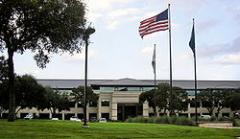
San Antonio has a diversified economy with four primary focuses: financial services, government, health care, and tourism. Located about 10 miles northwest of Downtown is the South Texas Medical Center, which is a conglomerate of various hospitals, clinics, and research (see Southwest Research Institute) and higher educational institutions.
The city is also home to one of the largest military concentrations in the United States. The defense industry in San Antonio employs over 89,000 and provides a $5.25 billion impact to the city's economy.
Twenty million tourists visit the city and its attractions every year, contributing substantially to the city's economy. The Henry B. Gonzalez Convention Center alone hosts more than 300 events each year with over 750,000 convention delegates from around the world. Tourism employs 94,000 citizens and makes an economic impact of over $10.7 billion in the local economy as revealed in the Economic Impact Study conducted every two years by the San Antonio Tourism Council and the research team of Dr. Richard Butler and Dr. Mary Stefl of Trinity University. Tourism also brings new annual revenues to the City of San Antonio and other governmental entities with the hotel & motel tax, sales taxes and other revenues from hospitality agreements and contracts. This number exceeded over $160 million in the 2004 study.
Of the 140 Fortune Global 500 companies headquartered in the US, San Antonio is home to two: Valero Energy Corp #33, and Tesoro Petroleum Corp #317.
San Antonio is home to five Fortune 500 companies: Valero Energy Corp, Tesoro, USAA, Clear Channel Communications and NuStar Energy. H-E-B, the 19th largest private company in the United States is also headquartered in San Antonio. Other companies headquartered in San Antonio are: Kinetic Concepts, Frost National Bank, Harte-Hanks, Eye Care Centers of America, Bill Miller Bar-B-Q Enterprises, Taco Cabana, Whataburger, Rackspace, NewTek, and Carenet Healthcare Services.
Other large companies that operate regional headquarters in the city include: Nationwide Mutual Insurance Company, Kohl's, Allstate, Chase Bank, Philips, Wells Fargo, Toyota, Medtronic, Sysco, Caterpillar Inc., AT&T, West Corporation, Citigroup, Boeing, QVC, and Lockheed Martin.
In between the beginning of 1997 and March 11, 1998, San Antonio lost several major company headquarters. In 1997 Titan Holdings and USLD Communications had sold their operations to larger companies. After a Los Angeles buyout specialist purchased Builders Square, the company's operations were moved out of San Antonio.
San Antonio is a popular tourist destination.
The River Walk meanders through the Downtown area. It was one of the first restorations of an urban river. Lined with numerous shops, bars, and restaurants, as well as the Arneson River Theater, this attraction is transformed into an impressive festival of lights during the Christmas and New Year holiday period, and is suffused with the local sounds of folklorico and flamenco music during the summer, particularly during celebrations such as the Fiesta Noche del Rio. Also based along the River Walk is the newly restored Aztec On The River, the only surviving exotic-themed movie palace in Texas.
San Antonio has claims on being the birthplace of the spicey stew known as chili. It was introduced to the nation when the city sent a 'San Antonio Chili stand' to the 1893 Columbian Exposition in Chicago. Chili is still widely available. In passing, San Antonio is also the home of the Frito, the Cheeto and David Pace's Pace picante sauce.
The Alamo, located in Downtown, is Texas' top tourist attraction. Because of the mission, San Antonio is often called the "Alamo City." The River Walk is the second most visited attraction. SeaWorld, located 16 miles (26 km) west of Downtown in the city's Westover Hills district, is the number 3 attraction. Also, there is the very popular Six Flags Fiesta Texas. Morgan's Wonderland is a theme park for special needs children.
The Downtown Area also features Cathedral of San Fernando, The Majestic Theatre, HemisFair Park (home of the Tower of the Americas and UTSA's Institute of Texan Cultures), La Villita, El Mercado, the Spanish Governor's Palace, and the historic Menger Hotel. On the northern side of the Alamo complex, beside the Emily Morgan Hotel, is the San Antonio Cavalry Museum, which features cavalry artifacts and exhibits and is frequented by local re-enactors.
The Fairmount Hotel, built in 1906 and San Antonio's second oldest hotel, is in the Guinness World Records as one of the heaviest buildings ever moved intact. It was placed in its new location, three blocks south of the Alamo, over four days in 1985, and cost $650,000 to move.

The Alamo, San Antonio's most famous attraction

The River Walk around Christmastime

San Antonio's historic River Walk extends some 2 ½ miles, attracting several million visitors every year.

Boat with sightseers on the San Antonio River

Another view of the city's downtown area

Central Library of The San Antonio Public Library

The Tower of the Americas characterizes the city's skyline

The historic Bexar County Courthouse

The San Antonio Convention Center

Rivercenter Mall in downtown San Antonio

The Buckhorn Museum with a plethora of western exhibits, is located in downtown San Antonio.

Pat O'Brien's Bar and Restaurant, based in New Orleans, Louisiana, has an outlet in downtown San Antonio.

San Antonio Children's Museum sign

Airplane exhibit at the San Antonio Children's Museum

Carriage rides in downtown San Antonio

The Shops at La Cantera is a non-enclosed shopping mall located near the University of Texas at San Antonio in the northwestern portion of the city.

The San Antonio Botanical Garden

San Antonio Missions National Historical Park

SeaWorld San Antonio

Aztec On The River Theater

IMAX Theater

C.H. Guenther and Sons flour mill and grain elevator

Emily Morgan Hotel

Tower Life Building

Henry B. Gonzalez Convention Center

Hot Wells, San Antonio, Texas (postcard, circa 1907)
San Antonio is home to the first museum of modern art in Texas, the McNay Art Museum. Other places of interest include The Southwest School of Art, The Woodlawn Theatre, the San Antonio Zoo, the Japanese Tea Gardens, Kumamoto, Brackenridge Park, the missions of the San Antonio Missions National Historical Park, the Museo Alameda, the San Antonio Museum of Art, the Witte Museum, the Texas Rangers Museum, the Buckhorm Museum, ArtPace, Blue Star Contemporary Art Center, SeaWorld San Antonio, Six Flags Fiesta Texas, the Texas Transportation Museum, and Splashtown San Antonio. Visitors can also experience something of the cowboy culture year round, they can see the 40-foot (12 m) tall cowboy boots at North Star Mall.
Beyond taking in the sights and sounds of San Antonio, tourists can sample some of its world famous Tex-Mex cuisine at the many fine restaurants located throughout the city. Mexican restaurants are abundant in virtually the entire city, and most are relatively inexpensive. Some outstanding examples of Tex-Mex eateries include Jacala, on West Avenue on the inner Northwest Side, La Hacienda de Los Barrios, on the Northeast Side, Tommy's, a chain with three locations in San Antonio (the first one located on Nogalitos at I-35 near Downtown), and Los Barrios, on the near North Side of town.
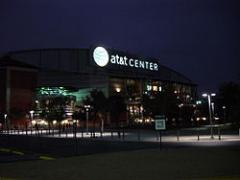
The city's only top-level professional sports team, and consequently the team most San Antonians follow, is the San Antonio Spurs of the National Basketball Association. Previously, the Spurs played at the Alamodome, which was built for football, and before that the HemisFair Arena, but the Spurs built aewith public money aeand moved into the SBC Center in 2002, since renamed the AT&T Center.
The AT&T Center is also home to the San Antonio Rampage of the American Hockey League and the San Antonio Silver Stars of the WNBA, both owned by the Spurs Organization. San Antonio is home to the Double-A Minor League affiliate of the San Diego Padres, the San Antonio Missions who play at Nelson Wolff Stadium on the west side of the city. (San Antonio is the largest city in the country with neither a Major League nor AAA baseball team.) San Antonio hosts the NCAA football Alamo Bowl each December.
San Antonio is also home to the San Antonio Gaelic Athletic Club which was established in early 2011. The club name is the San Antonio Defenders and plays in a Texas League with teams from Austin, Dallas, and Houston. The season ranges from April to the end of August where the team competes at the North American Gaelic Athletic Association tournament every Labor Day Weekend. The club also has two inter-squad teams the San Patricios and the I.C.A (Irish Citizen Army) that compete in a pub league in the fall.
San Antonio has two rugby union teams, the Alamo City Rugby Football Club, and San Antonio Rugby Football Club.
The city is also home to St. Mary's University and the University of Texas at San Antonio who field the only two collegiate Mens Rugby teams in the city. Both schools compete in Division III Texas Rugby Union, both schools are city and division rivals.
The University of Texas at San Antonio fields San Antonio's only NCAA Division I athletic teams known as the UTSA Roadrunners. The University recently added football, hiring former University of Miami coach Larry Coker as its initial head coach. Roadrunner football began play in 2011, with a record of 4-6. UTSA set attendance records for both highest attendance at an inaugural game (56,743) and highest average attendance for a first year program (35,521). The Roadrunners will move to the Western Athletic Conference in 2012, making the jump to Division 1 status faster than any program in history.
The city is also home of the U.S. Army All-American Bowl, played annually in the Alamodome and televised live on NBC. The Bowl is an East versus West showdown featuring the nation's top 90 high school senior football players. The game has featured NFL stars Reggie Bush, Vince Young, Adrian Peterson, and many other college and NFL stars.
City officials are said to be attempting to lure the National Football League permanently to San Antonio and have also said that a strong showing at the Alamodome for the three local Saints games was vital to proving that San Antonio can support an NFL franchise. Former NFL Commissioner Paul Tagliabue stated San Antonio was successful in hosting the team, and that the city would be on the short list for any future NFL expansions. The city has also hosted the Dallas Cowboys and Houston Oilers preseason camps in the past, and they have signed a contract with the Cowboys in which the Cowboys will practice in San Antonio through 2011. Cowboys owner Jerry Jones has acknowledged his support for the city's efforts to become home to an NFL franchise. Although it is the second largest city in the United States without an NFL team (after Los Angeles), San Antonio's smaller metropolitan population has so far contributed to its lack of landing an NFL, MLB, or NHL team.
The city got its first professional soccer team, the San Antonio Scorpions of the North American Soccer League, in 2010. They began playing in 2012 initially in Heroes Stadium pending the completion of a soccer-specific facility in the STAR Soccer Complex.
World Wrestling Entertainment superstar Michael Hickenbottom, or Shawn Michaels is billed as his hometown during his entrance.
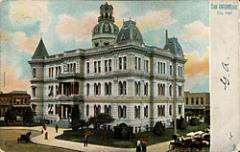
The City of San Antonio runs under a Council-Manager form of government. The city is divided into 10 council districts designed to ensure equal population distribution between all districts. Each district elects one person to sit on the City Council with the mayor elected on a city-wide basis. All members of the City Council, which includes the mayor, are elected to two-year terms and are limited to four terms in total (except for those who were in office in November, 2008 and are limited to a total of two terms). Houston and Laredo have similar term limits to those in San Antonio. All positions are elected on non-partisan ballots as required by Texas law. Council members are paid $20 per meeting, while the Mayor earns $4,000 a year. Most council members maintain full-time employment in addition to their positions on the council. The current mayor is Julian Castro.
The council hires the City Manager to handle day to day operations. The council effectively functions as the city's legislative body with the City Manager acting as its Chief Executive, responsible for the management of day to day operations and execution of council legislation. The current City Manager is Sheryl Sculley.
The city operates its own electric and gas utility service, CPS Energy.
The San Antonio Police Department (SAPD) is the city's municipal body of law enforcement.
The San Antonio Fire Department (SAFD) provides the city with fire protection and EMS service.
The city stretches into several national congressional districts and is represented in Congress by the following:
Unlike most large cities in the U.S., San Antonio is not completely surrounded by independent suburban cities, and under Texas state law it exercises extraterritorial jurisdiction (ETJ) over much of the surrounding unincorporated land, including planning major thoroughfares and enforcing rules for platting and subdivision. It pursues an aggressive annexation policy and opposes the creation of other municipalities within its ETJ. Nearly three-fourths of its current land area has been annexed since 1960.
In the 2000s the city has annexed several long narrow corridors along major thoroughfares in outlying areas to facilitate eventual annexation of growth developing along the routes. The city planned to annex nearly forty additional square miles by 2009. In May 2010, the City of San Antonio agreed to release thousands of acres of land in its extraterritorial jurisdiction along Interstate 10 to Schertz. The agreement releases a total of 3,486 acres (14.11 km2) of San Antonio's ETJ lands north of I-10 to Schertz. The ETJ lands are in an area bordered by FM 1518 to the west, Lower Seguin Road to the north, Cibolo Creek to the east and I-10 to the south.
Involuntary annexation is a controversial issue in those parts of unincorporated Bexar County affected by it. Residents, attracted to the outlying areas by lower taxes and affordable real estate values, often see annexation as a mechanism to increase property tax rates (which are primarily driven by school district taxes, not city taxes) without a corresponding improvement in services such as police and fire protection, while the city regards its annexation policy as essential to its overall prosperity.
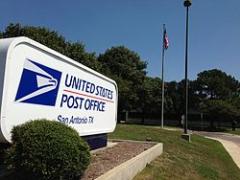
The Texas Department of Criminal Justice (TDCJ) operates the Parole Division Region IV headquarters in the San Antonio Metro Parole Complex. San Antonio district parole offices I and III are in the parole complex, while office II is in another location.
The Texas Department of Transportation operates the San Antonio District Office in San Antonio.
The United States Postal Service operates the San Antonio Main Post Office. Other post offices are located throughout San Antonio.
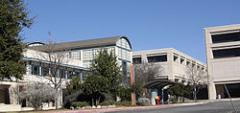
San Antonio hosts over 100,000 students in its 31 higher-education institutions. Publicly supported schools include the University of Texas Health Science Center at San Antonio, the University of Texas at San Antonio, Texas A&M University aeSan Antonio, and the Alamo Community College District. University of Texas at San Antonio is San Antonio's largest university.
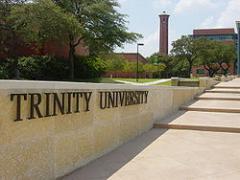
Private universities include top-rated Trinity University, St. Mary's University, Our Lady of the Lake University, University of the Incarnate Word, Baptist University of the Americas, and Wayland Baptist University. The San Antonio Public Library serves all of these institutions along with the 17 school districts within San Antonio.
The city is also home to more than 30 private schools and charter schools. These schools include: Central Catholic Marianist High School, Incarnate Word High School, Saint Mary's Hall, The Atonement Academy, Antonian College Preparatory High School, San Antonio Academy, Holy Cross High School, Providence High School, The Carver Academy, Keystone School, TMI ae The Episcopal School of Texas, St. Anthony Catholic High School, Lutheran High School of San Antonio, and Harmony Science Academy.
San Antonio is also home to U.S. Air Force Basic Military Training. The Air Force only has one location for enlisted basic training: the 737th Training Group, at Lackland Air Force Base. All new Air Force recruits go through the same basic training at Lackland. Each year, over 35,000 new recruits go through AFBMT. In addition, METC (Military Education and Training Campus), which provides the medical training for the U.S. military at Fort Sam Houston, hosts 30 programs and over 24,000 annual graduates. It is the largest medical education center in the world.
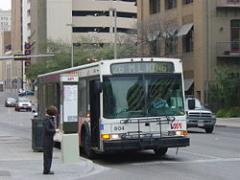
The San Antonio International Airport (SAT) is located in Uptown San Antonio, approximately eight miles north of Downtown. It has two terminals and is served by 21 airlines serving 44 destinations including six in Mexico. Stinson Municipal Airport is a reliever airport located six miles (10 km) south of Downtown San Antonio. The airport has two runways and it is also home to the Texas Air Museum.
A bus and rubber tired streetcar (bus) system is provided by the city's metropolitan transit authority, VIA Metropolitan Transit. VIA's full fare monthly unlimited Big Pass is only $30 per month, making VIA the most economically priced large transit authority in the USA. In August 2010, VIA Metropolitan Transit unveiled the next set of buses that are powered by diesel-electric hybrid technology.
The 30 hybrid buses are being put into service on VIA aos express routes to serve daily commuters across the city. This set of buses follows the introduction of new vehicles powered by compressed natural gas, which were unveiled in May 2010. In the fall of 2010, VIA will begin taking delivery of three new buses that will be powered by electricity from on-board batteries. These buses will service the Downtown core area, and they will be the first revenue vehicles VIA operates that have zero emissions.
VIA offers 84 regular bus routes and three Downtown streetcar routes. This includes express service from Downtown to park and ride locations in the South, West, Northwest, North Central and Northeast Sides of the city with service to major locations such as UTSA, Six Flags Fiesta Texas and SeaWorld. VIA also offers a special service to city events including Spurs games and city parades from its park and ride locations. VIA has, among its many routes, one of the longest local transit routes in America. Routes 550 (Clockwise) and 551 (Counterclockwise) travel 48 miles (77 km) one way as it loops around the city.
San Antonio became the largest city in the U.S. to not have an intra-city rail system when Phoenix, the former city that had this title, got such a system in 2008. VIA is currently in the process of creating a Bus Rapid Transit line known as VIA Primo. A proposed passenger rail line, LSTAR, would link the city to Austin.
Amtrak, the national passenger rail service, provides service to San Antonio at San Antonio Amtrak Station, operating its Texas Eagle daily between San Antonio and Chicago's Union Station. Amtrak also operates its Sunset Limited three times a week in each direction through San Antonio between Los Angeles and Orlando, Florida (currently truncated to New Orleans due to the effects of Hurricane Katrina).
The Texas Eagle section travels between San Antonio and Los Angeles as part of the Sunset Limited. The old Sunset Station is now an entertainment venue owned by VIA and neighbored by the current station and the Alamodome.
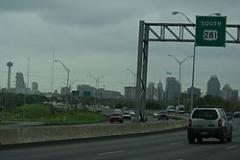
San Antonio is served by these major freeways:
Other highways include:
San Antonio has approximately 136 miles (219 km) of bike lanes, routes or off-road paths. Off-road trails travel along the San Antonio River, linear greenways, or city parks. Although largely disconnected, the progress to create a bicycle-friendly environment was recognized when San Antonio was designated a Bronze-Level Bicycle Friendly Community by the League of American Bicyclists.
A bike sharing service was approved by the city council on June 17, 2010. The initial program will consist of 140 bikes at 14 locations supported by a "central hub" and is expected to serve both residents and visitors. San Antonio Bike Share, a non-profit, is being formed to oversee the operation, which will be locally operated and maintained by Bike World. B-Cycle, the same system being used in Denver, will be supplying the bike share system. It started operation March 2011.
A 2011 study by Walk Score ranked San Antonio the 40th most walkable of the fifty largest cities in the United States.
San Antonio has one major newspaper, the San Antonio Express-News, which has served the area since 1865. Robert Rivard, who currently serves as the paper's executive vice president and editor, was named Managing Editor in 1994 and then Editor in 1997. The Express-News currently circulates as the largest newspaper service in South Texas. The Hearst Corporation, which owned a second newspaper, the San Antonio Light, purchased the Express-News from News Corp. in 1992 and shut down the Light after failing to find a buyer.
Hearst, using the Express-News brand, also produces Conexion, a weekly magazine written by an entirely Hispanic staff with a Hispanic spin on weekly events. The San Antonio Current is the free "alternative" paper published weekly with local political issues, art and music news, restaurant listings and reviews, and listings of events and nightlife around town. In addition, the San Antonio Business Journal covers general business news. La Prensa, a bilingual publication, also has a long history in San Antonio. The San Antonio River Walk Current covers general San Antonio news.
FM: 28 AM: 20
About 50 radio stations can be heard in the San Antonio area ae 30 of them are actually located in the city proper. San Antonio is home to Clear Channel Communications, the largest operator of radio stations in the U.S. Its flagship, WOAI AM-1200, is known for its local news operation, considered among the best in the country. The first radio station to broadcast in South Texas was KTSA AM-550 in 1922. Some of KTSA AM-550's better known local talk show hosts include Jack Riccardi, Trey Ware and Ricci Ware.
There are three National Public Radio stations in San Antonio, which belong to Texas Public Radio (www.TPR.org); KSTX 89.1 FM is NPR news/talk, KPAC 88.3 is a 24-hour classical music station, and KTXI 90.1 is a mix of NPR news/talk and classical music broadcast for the West Central Texas Hill County. KSTX also broadcasts "Riverwalk Jazz", featuring Jim Cullum Jazz Band at The Landing, a fixture on the River Walk since 1963.
KRTU 91.7 is a non-commercial radio station based out of Trinity University. Unlike other college radio stations throughout the U.S. the station plays jazz 17 hours a day and college rock/indie rock at night. College Alternative station KSYM, 90.1 FM, is owned by the Alamo Community College District and operated by San Antonio College students and like KRTU it plays the Third Coast music network during the day and alternative music at night.
Most Latin stations in the area play regional Mexican, Tejano or contemporary pop. On January 12, 2006, Univision-owned KCOR-FM "La Kalle 95.1" changed its format from Hispanic-Rhythmic Contemporary Hits to Spanish Oldies, then named "Recuerdo 95.1". However, Univision announced on November 10, 2006, that it flipped KLTO Tejano 97.7's format to Reggaeton in an attempt to reintroduce the format to San Antonio again. Then, 97.7 was flipped again to feature a rock format. The station no longer broadcasts anything in English and while still owned by Univision, it now broadcasts music from artists such as Linkin Park.
95.1 was then flipped back to the "La Kalle" format again after being flipped more than a year ago to feature a "95X" format. KLTO was acquired earlier in the year and operated as a simulcast of KXTN Tejano 107.5. San Antonio has quickly diversified in recent years, with the influx of non-Tejano Latinos, mostly from the East Coast, who are serving in the city's various military bases, as well as immigrants from Mexico. Therefore, just like in the rest of the country, radio station conglomerates have been changing formats in San Antonio to reflect shifting demographics.
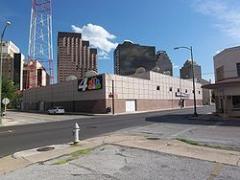
Despite the relatively large size of both the city proper and the metropolitan area, San Antonio has always been a medium-sized market. It presently only ranks 36th in the United States, according to marketing research firm ACNielsen. By comparison, the other two Texas cities with populations of over a million people, Houston and Dallas, are among the 10 largest markets. This is mainly because the nearby suburban and rural areas are not much larger than the city itself. Additionally, the close proximity of Austin truncates the potential market area.
San Antonio-based TV stations are WOAI channel 4 (NBC), KSAT channel 12 (ABC), KENS channel 5 (CBS), KABB channel 29 (Fox Broadcasting Company), KCWX channel 2 (myNetworkTV), KMYS channel 35 (The CW) and KLRN channel 9 (PBS). The market is also home to six Spanish-language stations, three religious stations, three independent stations and one Internet-based station (210 TV). The San Antonio market has 65% cable TV penetration.

Word Count: 7415







